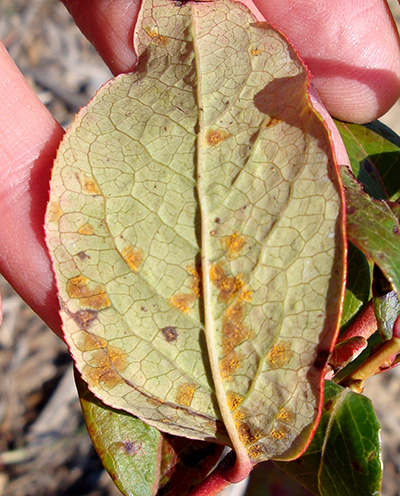Humid conditions are conducive to leaf rust in blueberries. Scout fields for the tell-tale orange spore pustules on the undersides of leaves. If rust is found, apply an effective fungicide to minimize the potential for premature defoliation.
Due to the humid conditions during the 2014 growing season, there is an increased risk of leaf rust in blueberries. Michigan State University Extension advises growers to keep an eye out for the tell-tale orange pustules. Rainy periods in mid- to late summer as well as longer dew periods are conducive to disease development. Leaf rust is caused by the fungus Thekopsora minima. Small yellow spots appear on leaves between July and September and then turn brown with a darker border. On older leaves, lesions may be surrounded by red or purplish discoloration. On the lower leaf surface, yellow to orange powdery pustules are visible with the naked eye or hand lens. These contain infective spores and, when touched, the spores come off.

Necrotic lesions on upper leaf surface.
Leaf rust can rapidly increase towards the end of the season under warm, wet conditions. It generally has little impact on current-season yield, but may cause premature defoliation. Severe defoliation has the potential to reduce fruitfulness of new buds or winterhardiness of the canes. No studies have been done on yield loss in blueberries due to leaf rust.

Orange rust pustules on lower leaf surface.
Biology
The rust fungus needs two plant hosts to complete the lifecycle. The alternate host of the fungus is the hemlock (Tsuga spp.), which explains why the rust tends to be more severe in the vicinity of hemlock trees. The hemlock plays an essential part in the lifecycle of the fungus. In spring, spores produced in overwintered blueberry leaves on the ground below blueberry bushes become airborne and infect hemlock needles. This infection may be difficult to see, but infected needles turn yellow and have cream-colored, tube-like projections hanging from them on the lower surface. Spores from these are airborne and infect blueberry leaves anytime from June to August.
Once blueberry leaves are infected, spores produced in the rust pustules are spread by wind and re-infect blueberry leaves in the presence of water from rain, dew or overhead irrigation. There can be repeated cycles of infection as long as conditions are right for infection. In the fall, the fungus drops to the ground with the leaves and overwinters in the field until the next growing season. In regions where green leaves are present year round, such as in the southern United States or in the greenhouse, hemlock trees are not needed to complete e the life cycle.
Management
Removing all hemlock trees within 0.5 miles from a blueberry field would break the rust lifecycle, but is neither desirable nor practical. Besides, hemlocks are a beautiful part of the Michigan landscape. Raking or chopping up blueberry leaves after leaf drop in the fall can reduce inoculum carry-over. Minimize leaf wetness by adjusting timing of overhead irrigation and apply effective fungicides in mid- to late summer. The most effective fungicide is Pristine (pyraclostrobin + boscalid), but Indar (fenbuconazole), Orbit (propiconazole) and Quash (metconazole) are also effective, especially when applied in the early stages of the epidemic. Do keep in mind that Indar and Orbit have a 30-day pre-harvest interval (PHI) and Quash has a seven-day PHI. Bravo (chlorothalonil) has moderate activity and has a 42- day PHI. However, after harvest, all of these fungicides can be sprayed provided that the maximum number of sprays per season is not exceeded.
A tank-mix of a sterol inhibitor fungicide, such as Indar or Orbit, with a half rate of Bravo is another option for both protectant and curative activity. Serenade (Bacillus subtilis), an organic biofungicide with a zero-day PHI, has moderate to good activity against blueberry rust – adding a sticker-extender like Nufilm P may improve efficacy. Dormant lime sulfur applied to the leaves on the ground in the fall or spring may be helpful in reducing overwintering inoculum, but efficacy has not been confirmed.
Source : msu.edu